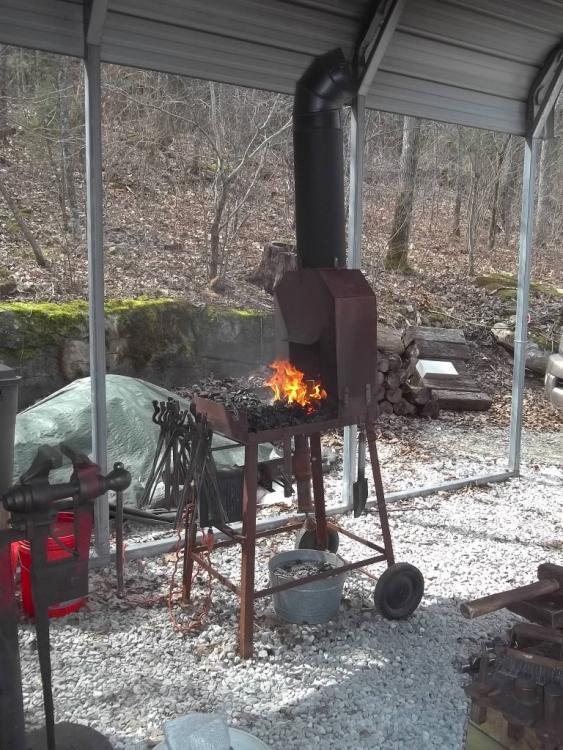-
Posts
2,679 -
Joined
-
Last visited
Content Type
Profiles
Forums
Articles
Gallery
Downloads
Events
Everything posted by arkie
-
I figured Old Charles has been using a ghost writer!!
-
Hey, Charles, your's has been pretty good lately! Spelling, that is.
-
"You can please some of the people all of the time, and all of the people some of the time"...but on forums, it's a never ending job. Thanks to Glenn and the mods for keeping IFI a clean forum. Practice by looking in the mirror and...wrinkling up your nose and forehead, gritting your teeth and growling loudly.
-
Works great on spikes, too. Best of all, it's cheap and you can stick your fingers in it!!
-
Eric, thanks for the suggestions. Even though it's a "portable" forge, I pretty well need to keep it as it's arranged what with my anvil and post vise located accordingly. I guess my original question was rambling and poorly worded...the gist of it was would it be better to have a longer 8" or a shorter 12" stove pipe? I just yesterday finished cutting out sheet metal for a new hood, being a bit larger to accommodate a 12" stack.
-
My forge is a semi-portable brake drum type that I use it under a tall (8' eave, 10' top) metal carport. Currently, the flue is a four foot piece of 8" stove pipe with a 45* top to divert the smoke to the center of the roof, as can be seen in the attached photo. Most times it draws well, but only with a fairly strong fire. I don't want to put a hole in the roof and if I divert it out to the sides, I run the risk of embers blowing out into the dry leaves, etc. on my hillside. I have two fairly easy options: (1) extend the stove pipe another 3 feet or so, or (2) make another hood but extending out over the firepot more. If I make another hood, I can increase the stove pipe to a 12" or larger size; right now I'm restricted by the hood top to an 8" pipe. Would it be better to extend the 8" stove pipe as long as possible, keeping it inside the roof, or make a larger hood with a 4 to 6 foot 12" stovepipe? As a Rube Goldberg arrangement, I could also make an long, angled stove pipe and attach it to the tallest part of the roof at the open end.
-

Please help identify my "new" anvil... JUNIATA
arkie replied to JHBurkhart's topic in Anvils, Swage Blocks, and Mandrels
That's a nearly 4 year old post you replied to...... -
EJ, good job! Now, you stay out of the beer for testing your openers.
-
I'll bet you REALLY had a clean tongue...at least no rust on it :-)
-
Hey, Frosty....I just realized why the Naval Jelly wasn't working for me!!!!!! I was putting it in my navel !!
-
I may try the diluted soak to see if it works better for small pieces.
-
I've tried Naval Jelly, but never had much luck with it. Vinegar is my brew of choice.
-
Steve, thanks for the size info and picture. That's a nice size to forge with. "Fines" are the sand and dust size coal. Fines are OK to forge with. The fines in bituminous coal clump together well and can coke just like larger pieces. Anthracite coal like you have doesn't coke like bituminous, but they will still burn. (I understand the TSC coal is anthracite...please correct me if I'm wrong.)
-
Steve, glad you were finally able to get your hands on some coal!! BTW, when TSC says "nut size", how big are the pieces and do they have much fines in the coal?
-
There have been several discussions on the merits (or demerits) of simply using vinegar to remove rust from steel. I finally got around to shooting some before and after photos of VERY rusty horseshoes that I needed to de-rust to show how effective, simple and easy it is. I do this all the time; cleaned up 13 horseshoes this go-round. These had been laying around in the wet dirt for who-knows how long. I wire brushed the loose stuff off with my anvil wire brush, removed any nails then covered them with regular white vinegar in a plastic bucket. They soaked for a couple of days then I neutralized them with a weak baking soda solution, rinsed with water and dried. I buffed the shoes with the wire wheel on a bench grinder and they shine like a new silver dollar (wish those were still silver...).
-

Vertical weld at floor level
arkie replied to John in Oly, WA's topic in Welding/Fab General Discussion
Also, if your bead is convex, you may have been running a little cold on amps. -
Steve, did you check with Saltfork in Oklahoma...their coal is MUCH cheaper but membership is required (I think we went this route before....??) Might be worth joining.
-
Nice job on the sideboards ☺
-
Wolverine Durashock Wellington slip-ons. Very comfortable on your feet when standing for long times and particularly on gravel. No laces or tongue to catch hot thingys.
-

Vinegar to remove Galvanized coating.
arkie replied to LouieIV's topic in Zinc, galvanized, and coatings
Frosty's comments are spot on. Plus....when they quit bubbling, the zinc removal should be finished. For washers, it takes me only a couple of hours at the most. Keep stirring the mix to assure complete removal. -
Steve, Have you checked into the Saltfork Craftsmen Artist-Blacksmith Association? They are Oklahoma-based, but have groups all over Oklahoma. They sell coal but to members only. They might be closer to you than some of the Texas blacksmith associations. Google for the link and you can read some of their newsletters.
-
Steve, That mesquite is better put to use in a BBQ!!!!!
-
Forging Carver, Gary Huston and Chandler Dickinson have some videos on making the horseshoe hearts, if you haven't seen them. They show how to form the top part using the horn.
-
I can assure you that the ballistic missiles they are shooting off aren't made from stuff they sell at HF!!!!!
-

Oilfield Pipe Suitable for Hawks?
arkie replied to olfart's topic in Axes, Hatchets, Hawks, Choppers, etc
Slag, Your post with the text completely underlined is EXTREMELY hard to read. I just skipped trying to read it. Try to post with normal text, please.

